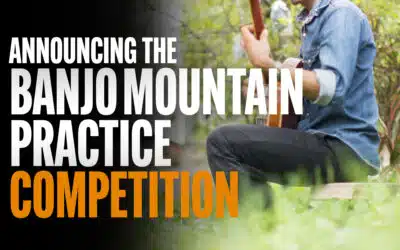While reading tablature is an essential component in learning to play banjo, there is always the danger that students can develop too much dependence on banjo tab. If this dependence continues over the course of years, they may never feel comfortable playing spontaneously with others (which, after all, is the point of bluegrass).
Even worse, they may never develop the muscle required to create music in the moment. And bluegrass is all about creating music in the moment.
It’s not about simply playing rehearsed banjo tab arrangements. Not if you want to improve as a picker. I always tell my students to think of tablature as a signpost or road map that merely points the way. At a certain point they’ll need to begin weaning themselves off tab (despite how impossible this might seem) so that they can create their own “way”.
When a student’s learning is focused exclusively on memorizing note-for-note banjo solos, the act of playing with others will continue to feel like an insurmountable burden.
I’ve personally found that if this reliance on tab is never addressed, the student’s optimism about the instrument will eventually fade and their motivation to continue soon peters out. And with no motivation, there can be no progress.
So, just what exactly is the secret ingredient necessary in maintaining motivation on the banjo? You might be surprised to learn that it’s the same ingredient that sustains our motivation when learning any new skill: curiosity.
When I say curiosity, I’m speaking of a willingness to move beyond tablature, to make your own attempts (fumbling as they might at first seem) to figure out things on your own; to create your own “way” without relying exclusively on a teacher to spoon feed you a repertoire.
Whether you know it or not, you’ve already got a ton of material ripe for exploring.
For instance, can you figure out the chords to that folk tune you love so much? Can you pick out the melody to that song you used to sing back in grade school? Are you able to plug in a roll over a chord progression for a song whose chords you already know? How does Earl Scruggs play that lick at the beginning of “Shuckin’ the Corn”?
Do you think you might be able to transcribe that banjo solo on your favorite bluegrass album after slowing it down? Can you pick out that song’s key? Do you know any basic licks on the banjo that you could employ in a basic (slow) jam or cobble together into a rudimentary banjo solo for a song you like?
Are you patient enough to sit down and try any of these things?
Granted, none of them are easy, but if you can let go of some of the anxiety surrounding questions like these, the exploration can be exciting, even addictive. You’ve only got to be willing to try.
The rewards will be plentiful, I guarantee it.
I know this for a fact because this is how I learned banjo as a kid. Typically, I would take a banjo solo from one of my records and, using my variable-speed tape recorder, record the solo, then play it back at the slower speed. If it wasn’t slow enough for me to figure out what was going on (which was usually the case), I played back this slowed down version on a second tape recorder while recording the playback. Then I’d take the new slower recording and play it back on my variable-speed tape recorder at an even slower speed.
Of course, using a slowed down recording meant that the banjo’s pitch in the new recording would be substantially lower than in the album’s recording. This would require re-tuning my banjo to the key of the slowed down recording (man, that was hard!).
I’d then attempt to transcribe what I heard on the slowed down recording, committing my transcription to tablature. Then I’d rehearse the solo over and over until I didn’t need the tab for it anymore and could play along with the original recordings. In time, I internalized these solos; the licks that comprised them eventually became part of my banjo vocabulary.
Was this process difficult? Hell, yes! Painstaking and time consuming? You bet your ass! So, what sustained me through this crazy process, you ask? The answer is simple – my desire to figure out how to reproduce the sounds on those records.
To put it another way – my curiosity! Naturally, this type of exploration will require you to venture out of your comfort zone. No need to worry – you can do it if you set your mind to it. Believe it or not, it’s actually kind of fun. All it takes is a little patience and a willingness to discover and learn. Just let your curiosity guide you and be ready to follow. The journey will be well worth it!
FULL ACCESS TO 200+ LESSONS
3 GREAT OPTIONS FOR YOU

Annual Subscription
SAVE OVER 70%Full access to Banjo Mountain (200+ lessons) for $139.95 saving you over 70%.
Bills annually. Cancel anytime.
3-Month Subscription
Full access to Banjo Mountain (200+ lessons) for $75 saving you over 35%.
Bills every 3 months. Cancel anytime.
1-Month Subscription
Full access to Banjo Mountain (200+ lessons) for $40.
Bills monthly. Cancel anytime.
STILL NOT SURE?
Latest From Our Blog
Nora Brown: A Rising Star In The Banjo World
Nora Brown is someone to keep your eye on. Indeed, at a young age, she is already turning heads. Hailing out of Brooklyn, New York, Nora has played festivals all over the country. Don’t let Brooklyn throw you off (no offense Brooklyn-ites). While having urban origins,...
The 1st Banjo Mountain Practice Competition
We are pleased to announce the first Banjo Mountain Practice Competition. This is for Banjo Mountain students. It costs nothing to enter and you can do so once you have subscribed. The goal here is to encourage daily practice by submitting your video for your peers to...
Kendl Winter Interview & Banjo Tips
Video interview with Kendl Winter where she shares tips and advice for banjo players, talks about how she got into banjo, what projects she's currently working on and her upcoming album "Banjo Mantras." Her single "Humming Mantra" will be live September 8th! A...



